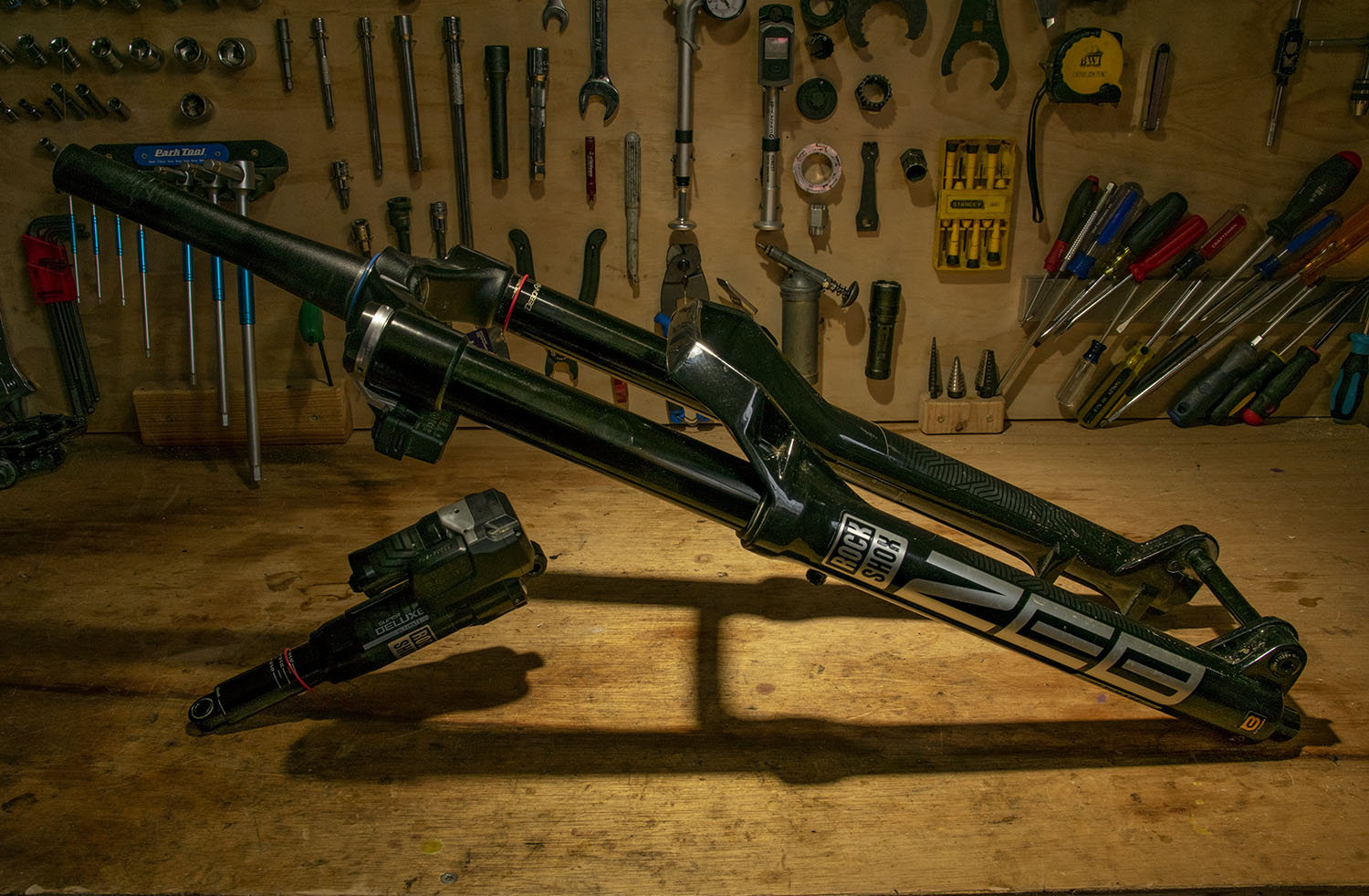
Intro
We’ve already gone deep on RockShox’s Flight Attendant electronic suspension with RockShox’s Chris Mandell in Ep. 102 of Bikes & Big Ideas and the engineering effort that went into it, but how does it perform on the trail? We’ve now had two reviewers spending time on Flight Attendant, and the difference it makes in terms of pedaling efficiency isn’t subtle. But is that worth ponying up for? The answer depends a lot on your budget and preferences, but for some people it’s going to be a resounding “yes,” because Flight Attendant is a whole lot more than an automatic climb switch.
Design
So what is Flight Attendant? The short version is that it’s an electronic suspension system that’s all about making your bike pedal more efficiently. It goes about that by adding an electronically-controlled module to the damper of both the fork and shock that can automatically toggle between one of three compression damping modes on the fly. A sensor in the crank spindle lets the system know when you’re pedaling to help the fork and shock decide what mode to be in at any given moment, and all three communicate wirelessly. Currently, Flight Attendant is available on the Super Deluxe Ultimate Air rear shock and Pike, Lyrik, and ZEB Ultimate forks, but only on complete bikes — there’s no aftermarket version, at least for now.
Fox has had their Live Valve system on the market for some years now, and at a high level, Flight Attendant is similar — they’re both electronically-controlled suspension systems that firm up the compression damping when appropriate, with the goal of improving pedaling efficiency. But the details are pretty different. For one, Flight Attendant is wireless, whereas Live Valve requires wired connections between the fork, shock, the main control unit in the middle of the frame, and a couple of extra sensors. And Live Valve toggles the fork and shock between two modes, Open and Firm; the Flight Attendant fork and shock have three basic modes: Open, Pedal, and Lock.
Open is essentially the descending mode, the same as a conventional fork, and a rear shock with the climb switch disengaged. Pedal mode firms up the compression damping considerably, and Lock does so even more. It’s not quite a true lockout, but it’s pretty close, especially in the rear shock. And the Flight Attendant system toggles the fork and shock between all three modes depending on whether or not you’re pedaling, how the bike is pitched (i.e., how much it’s pointed up or down hill), what kind of bumps it’s experiencing, and what kind of bias toward open vs. closed the user selects. There’s also a manual mode if you want to override the electronic overlord, but the real magic is in how Flight Attendant operates in the automatic setting.
The fork, shock, and crank sensor need to be used in conjunction with each other; there’s a bit of extra functionality you get (more on that in a minute) by pairing the whole system with a Reverb AXS dropper post and SRAM AXS drivetrain, but they’re not strictly required. But at least so far, the complete bikes that feature Flight Attendant come with the complete package of RockShox / SRAM wireless wizardry.
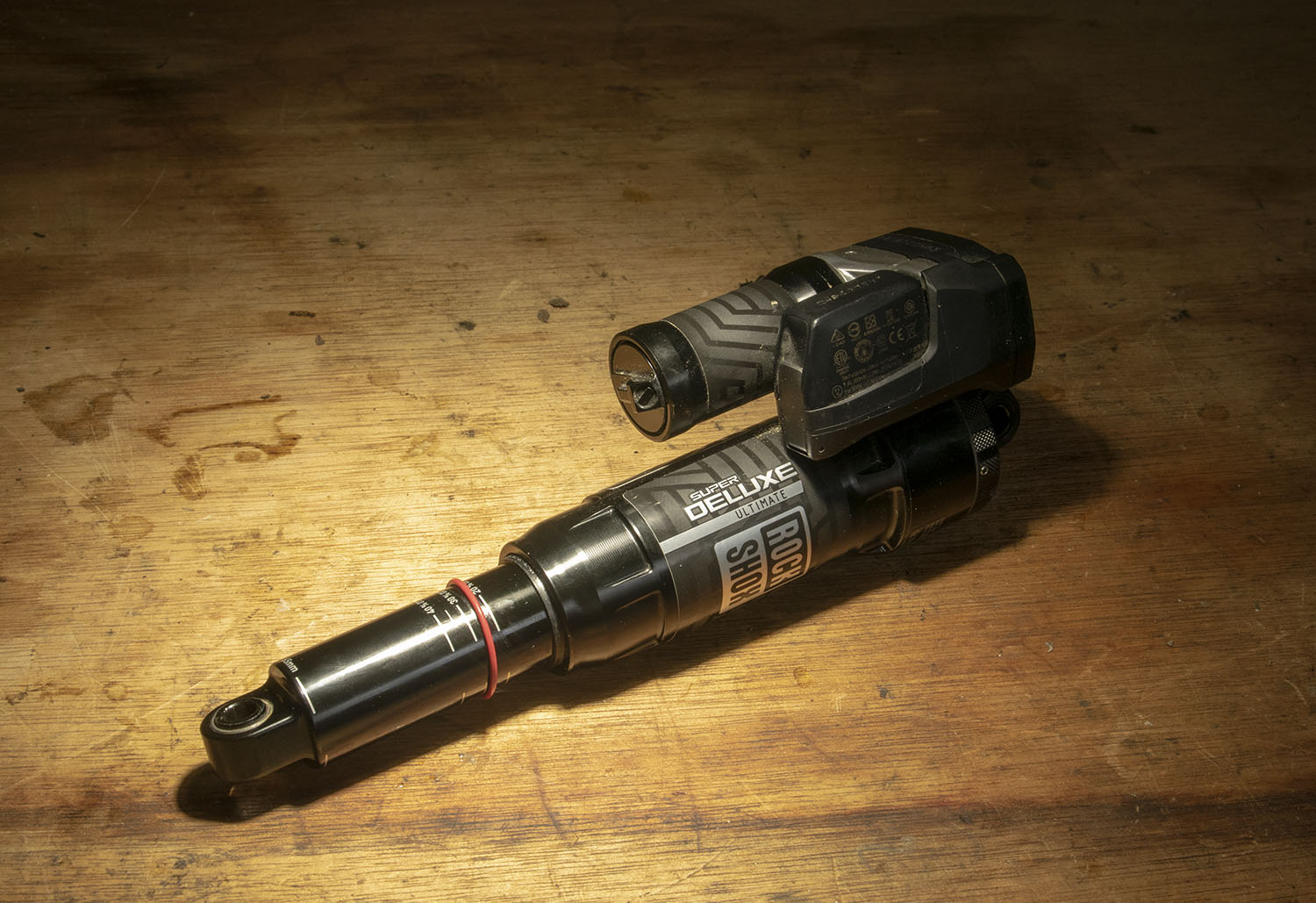
The fork and shock modules are each powered by a standard SRAM AXS battery, which will be familiar to anyone who’s used an AXS dropper post or rear derailleur before; the crank sensor takes a single AAA battery. Pair all that with an AXS dropper and derailleur, plus the controller modules for both, and you’ve got a total of seven batteries to power the whole shebang, which, [consults abacus] is… a lot. RockShox says that the fork battery should last 20-30 hours of ride time, and the rear shock one will handle 30-40. Both are easily removed for recharging; swapping the pedal sensor battery is slightly more involved, but that one’s good for a claimed 200 hours of ride time. If one of the batteries dies mid-ride, the system reverts to open mode — so you’ll lose the efficiency gains, but your suspension will still work normally. Hardly the end of the world.
The control unit on top of the right fork leg is the brain of the system and the primary interface through which you set up and control Flight Attendant. The SRAM AXS phone app gives you a few extra features for fine-tuning things (more on that below, too), but it’s not necessary to get you on your way. All the really important stuff can be handled by the three buttons on top of the fork leg — a mode selector and plus / minus toggles to change settings — while a set of five LEDs around the perimeter indicates the details of the setup.
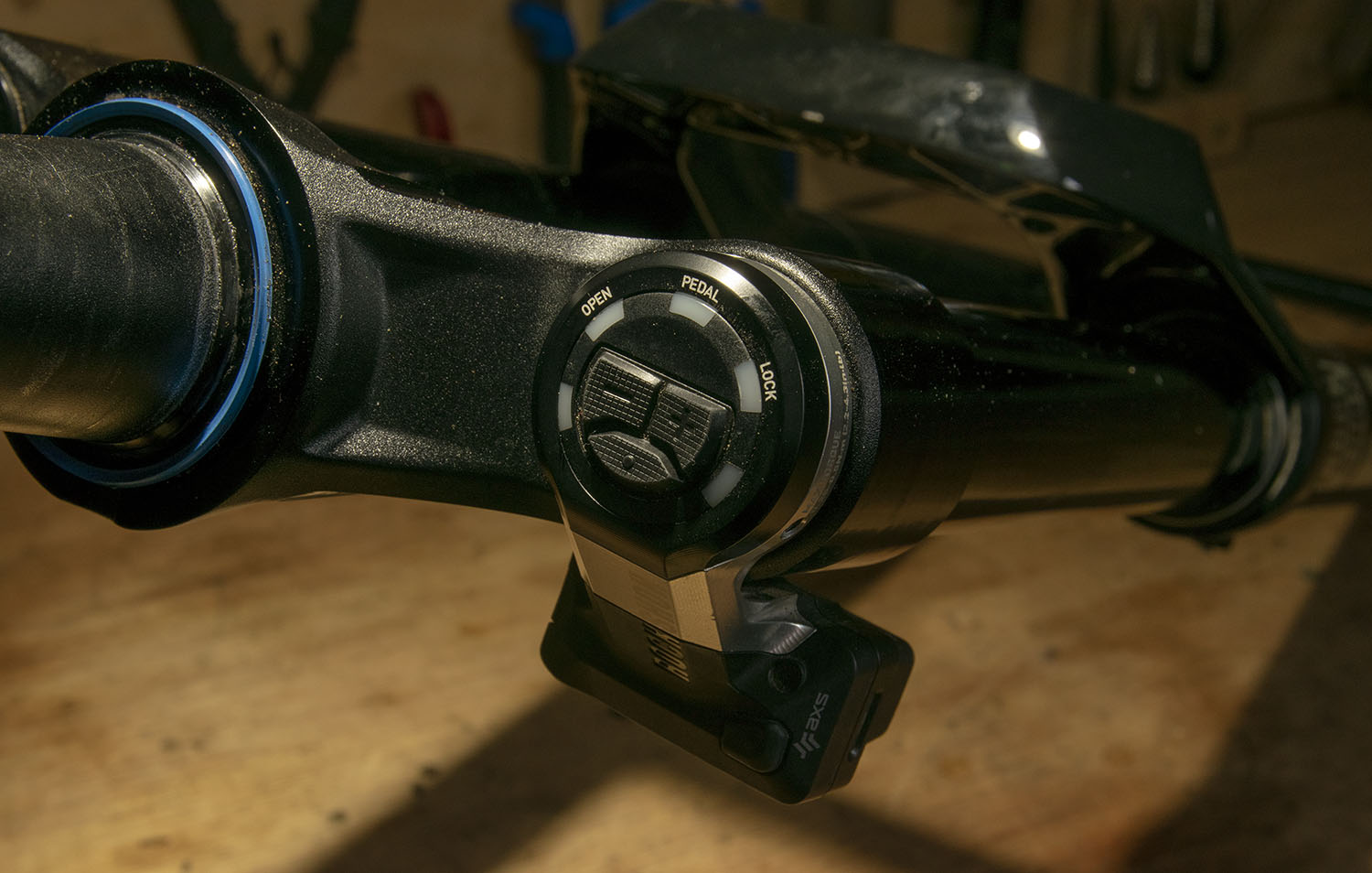
Setup & Settings
The suspension setup procedure for a Flight Attendant-equipped bike is only slightly more involved than a conventional one. After setting sag per usual (best done with Flight Attendant set to open mode, to get an accurate reading), there’s a quick calibration procedure to run through.
(1) Sit on the bike on flat, level ground such that the bike sags roughly as normal.
(2) Press and hold both the plus and minus buttons until the middle LED flashes white, then release the buttons and hold that position until the white LED flashes faster. If a red LED flashes to either side of the white one, lean the bike slightly away from that side until the red light disappears and wait until the white LED flashes quickly.
(3) Once the white LED flashes quickly, a red LED will light up to its right. Lean the bike to the left until the red light disappears, and then wait until the white light flashes quickly again.
And that’s it for the calibration. Your next setting (accessed by a quick press of the menu button) is the “Bias Adjustment”, which sets how aggressively Flight Attendant seeks out opportunities to take the suspension out of Open mode. The default is the middle setting, which RockShox calls “0”’; +1 and +2 will select firmer settings more quickly, and -1 and -2 bias the system more towards Open mode. Magenta lights indicate that you’re setting the Bias Adjustment; with that displayed, press the plus or minus buttons to change the setting. An additional press of the menu button brings you to the low-speed compression setting for the fork (blue) and then shock (teal). Each has 10 settings, with each of the five LEDs able to display half-brightness or full illumination to indicate the chosen settings. A long press of the menu button will exit out of the settings mode, or you can simply wait for it to time out on its own.
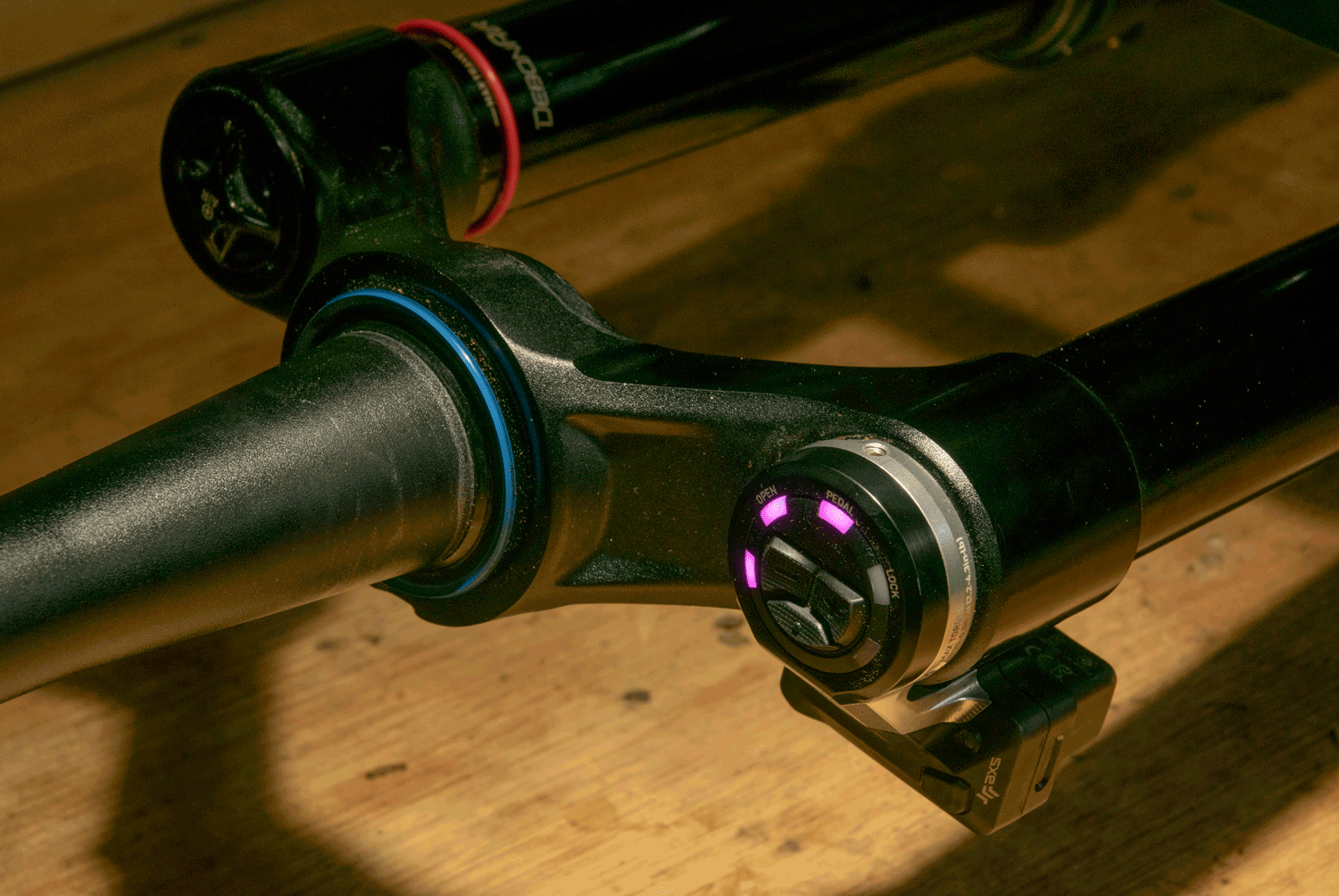
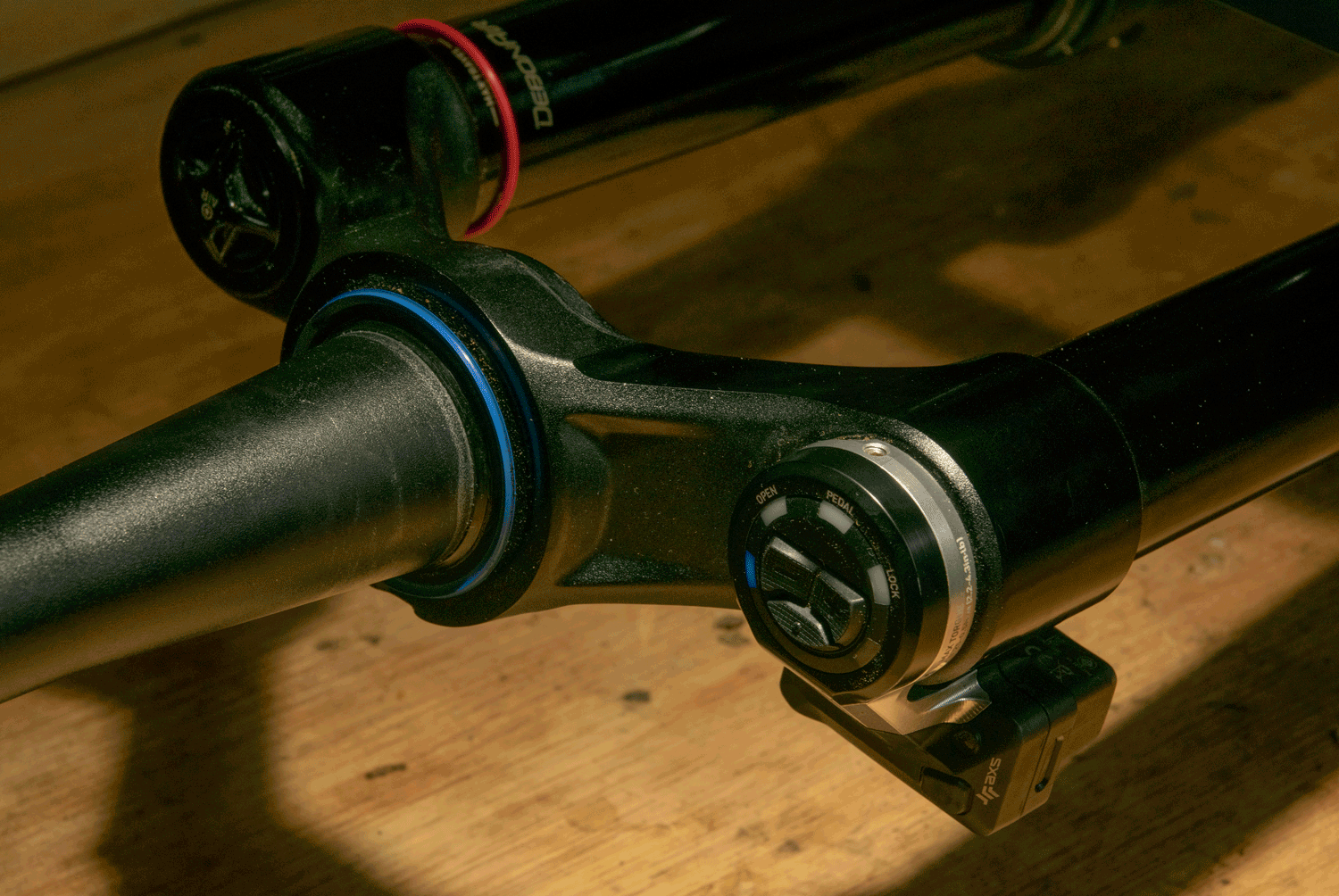
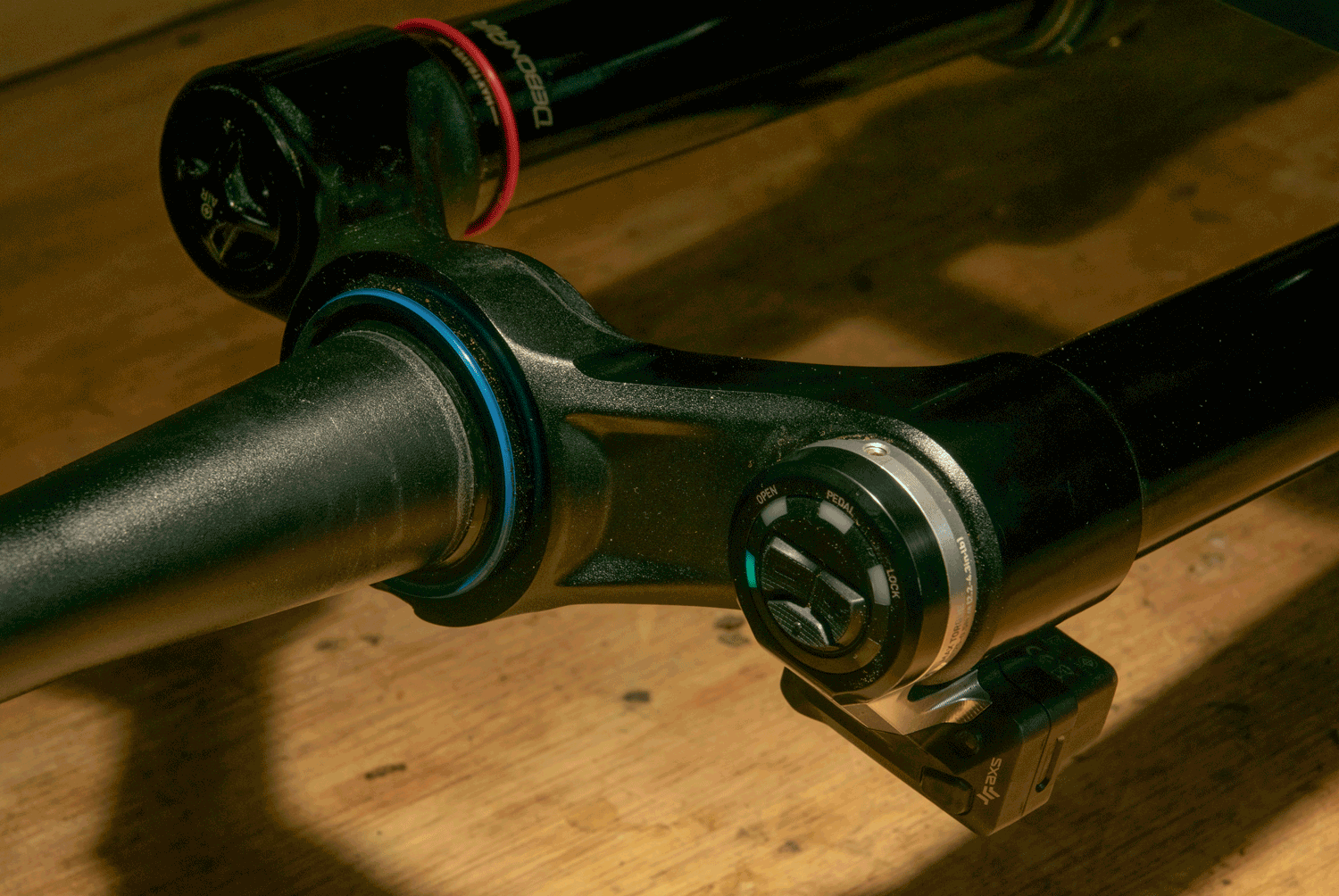
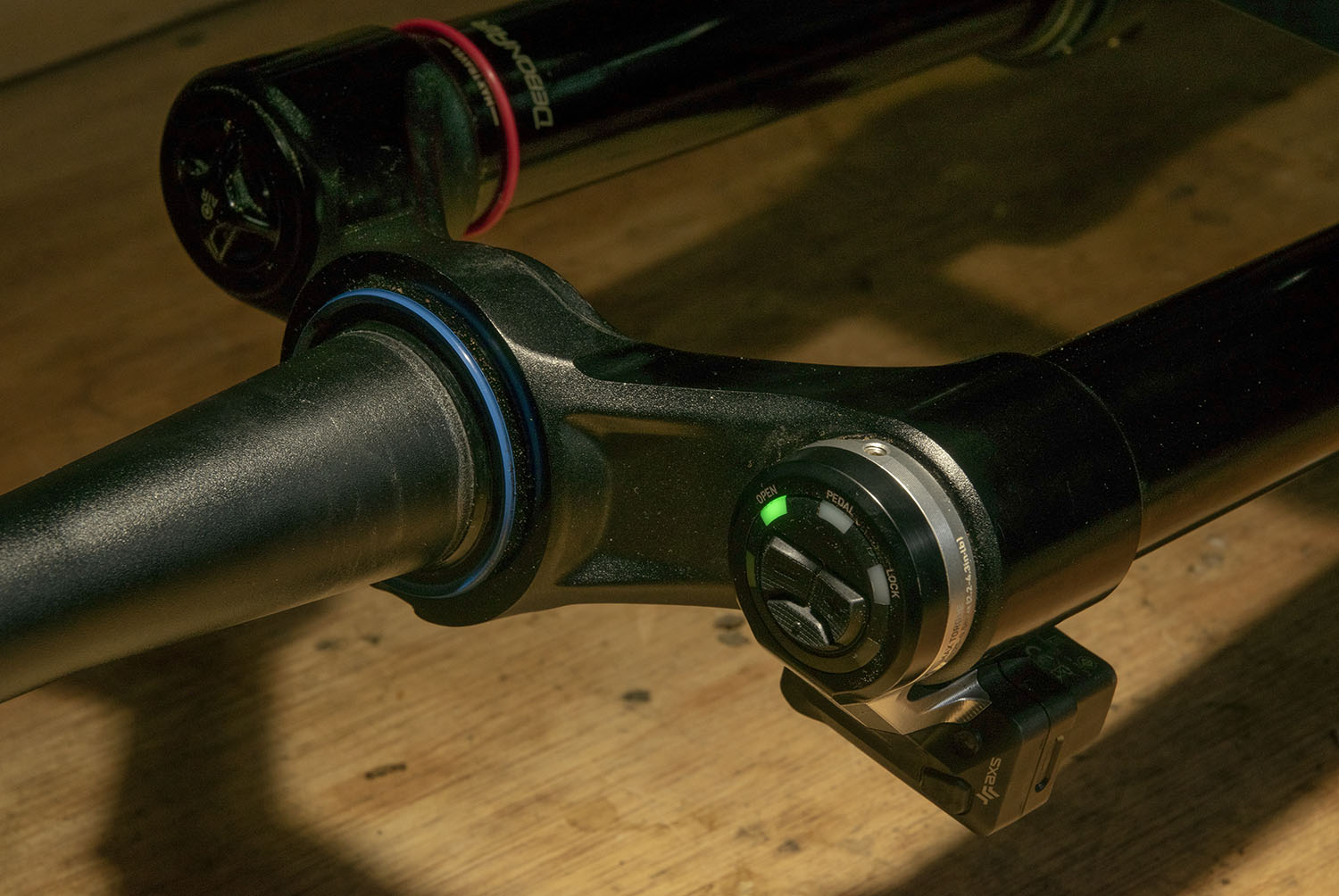
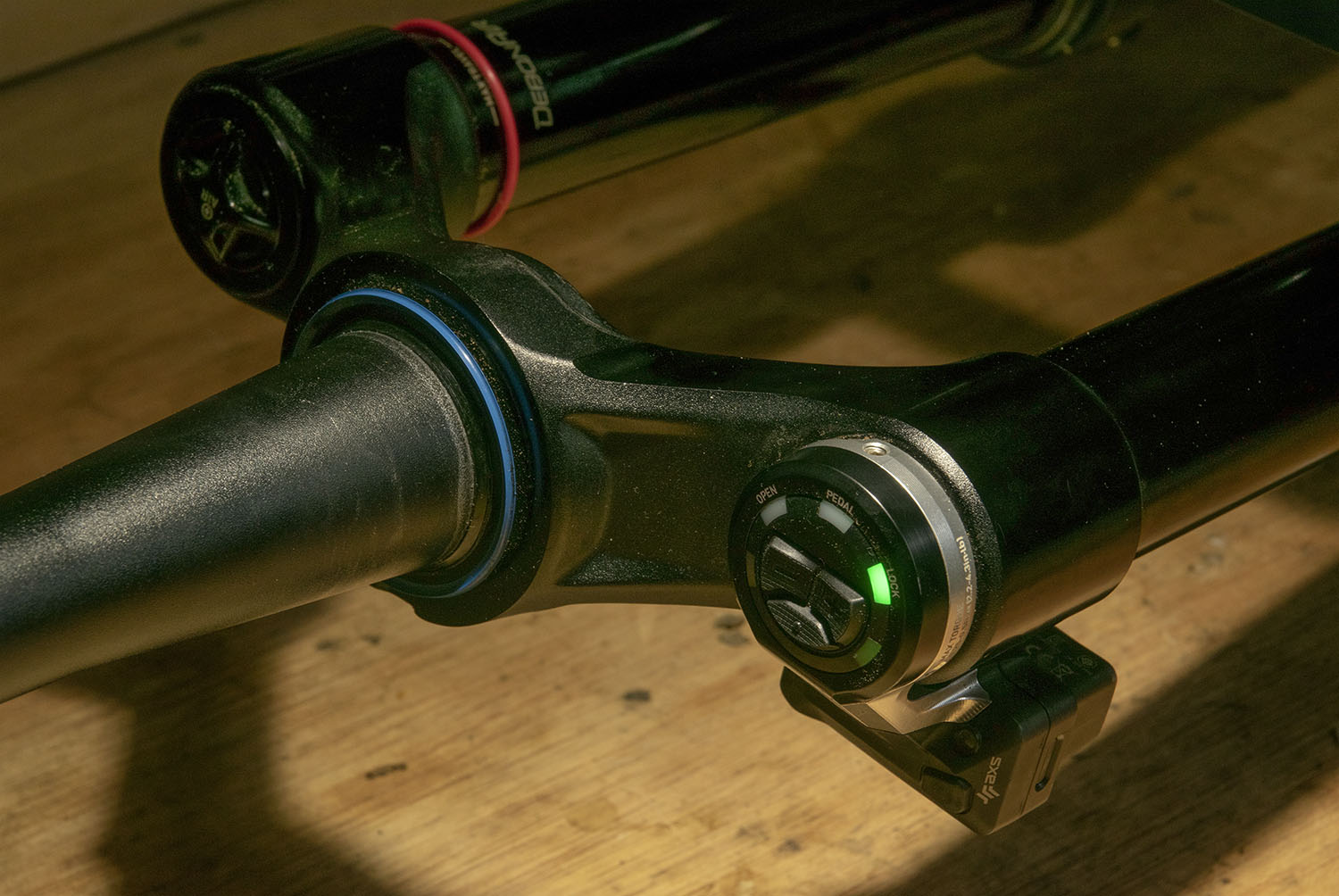
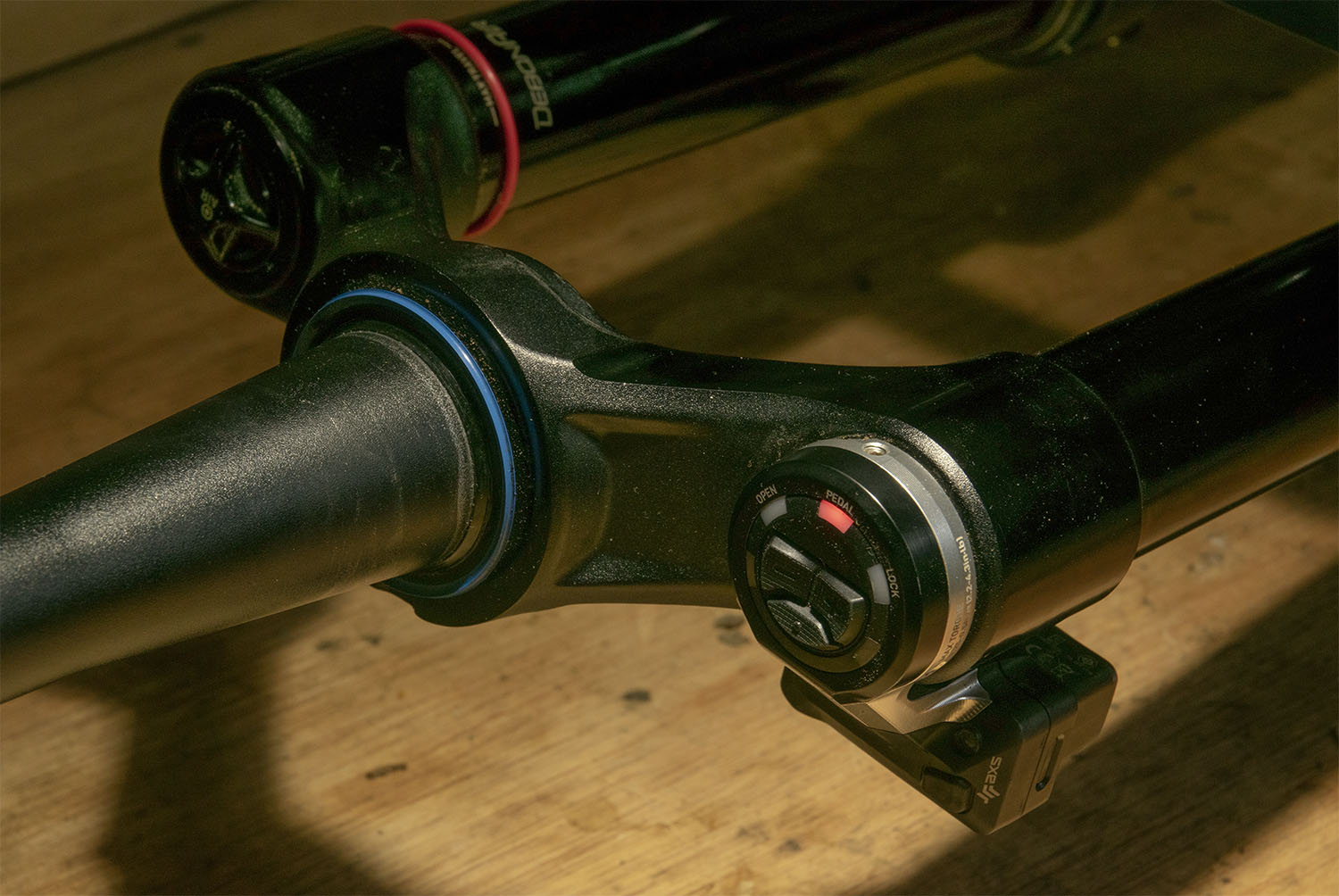
That might sound like a lot of stuff to figure out, but it’s all very straightforward and intuitive once you’ve spent a few minutes playing with the system. If you prefer, you can also make all the same adjustments through the SRAM AXS app, but it’s not necessary to get on the bike and ride. The only things that you absolutely need to use the app for are programming which AXS control buttons you want to do which action (e.g., which shifter paddle shifts up vs. down). If your bike is equipped with an AXS dropper post and the version of the remote with two paddles, you can also program that extra paddle to set Flight Attendant into the suspension setting of your choice (Open, Pedal, or Lock) with a long press of that paddle. The app also gives you more detailed battery status information and is used to perform firmware updates, but it’s not going to be a regular part of the day-to-day Flight Attendant experience for most people.
Currently, Flight Attendant is available on a limited range of bikes: the Trek Slash, YT Capra, Canyon Neuron, Specialized Enduro, Canyon Spectral, and YT Jeffsy. The Slash gives the best insight into pricing of those models, since it’s the only bike to offer an otherwise-identical build with and without Flight Attendant — and in that case, the electronic suspension bumps the price up by an even $1,000.
Flight Attendant also adds a bit of weight — roughly 300 g, according to RockShox — and also does away with the high-speed compression adjustment on the fork. But the new Flight Attendant-equipped forks get a couple of new features, beyond just the electronics. First, there are pressure relief valve buttons on the back side of each lower leg — just like what Fox has been doing for a few years now — and there are also new rubber isolators at the connection between the lower legs and the spring and damper shafts. RockShox calls them “Buttercups” and the idea is to mute certain frequencies of vibration that would otherwise be passed up through the fork to the rider. I’d bet we see both of those features on a new generation of RockShox forks sooner rather than later, but they’re Flight-Attendant-only at least for now. [Update: Yup.]
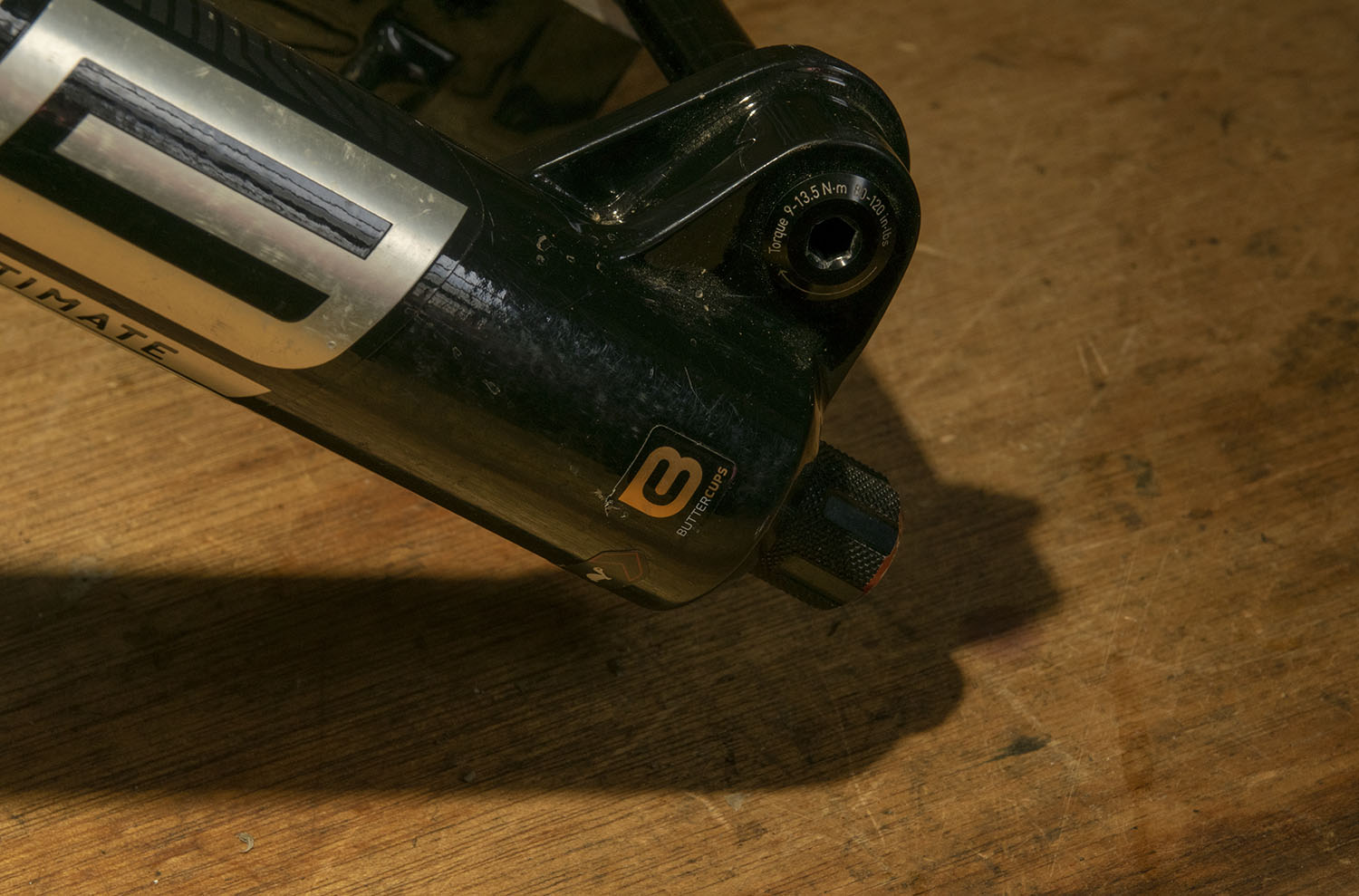
Flash Review
Blister Members can read our Flash Review of Flight Attendant for our initial on-trail impressions. Become a Blister Member now to check out this and all of our Flash Reviews, plus get exclusive deals and discounts on gear, and personalized gear recommendations from us.
Full Review
We’ve now had two reviewers spending time on the Flight-Attendant-equipped YT Capra Uncaged 6, and the performance of the system is very impressive. But what sorts of riders are going to find it worth springing for?
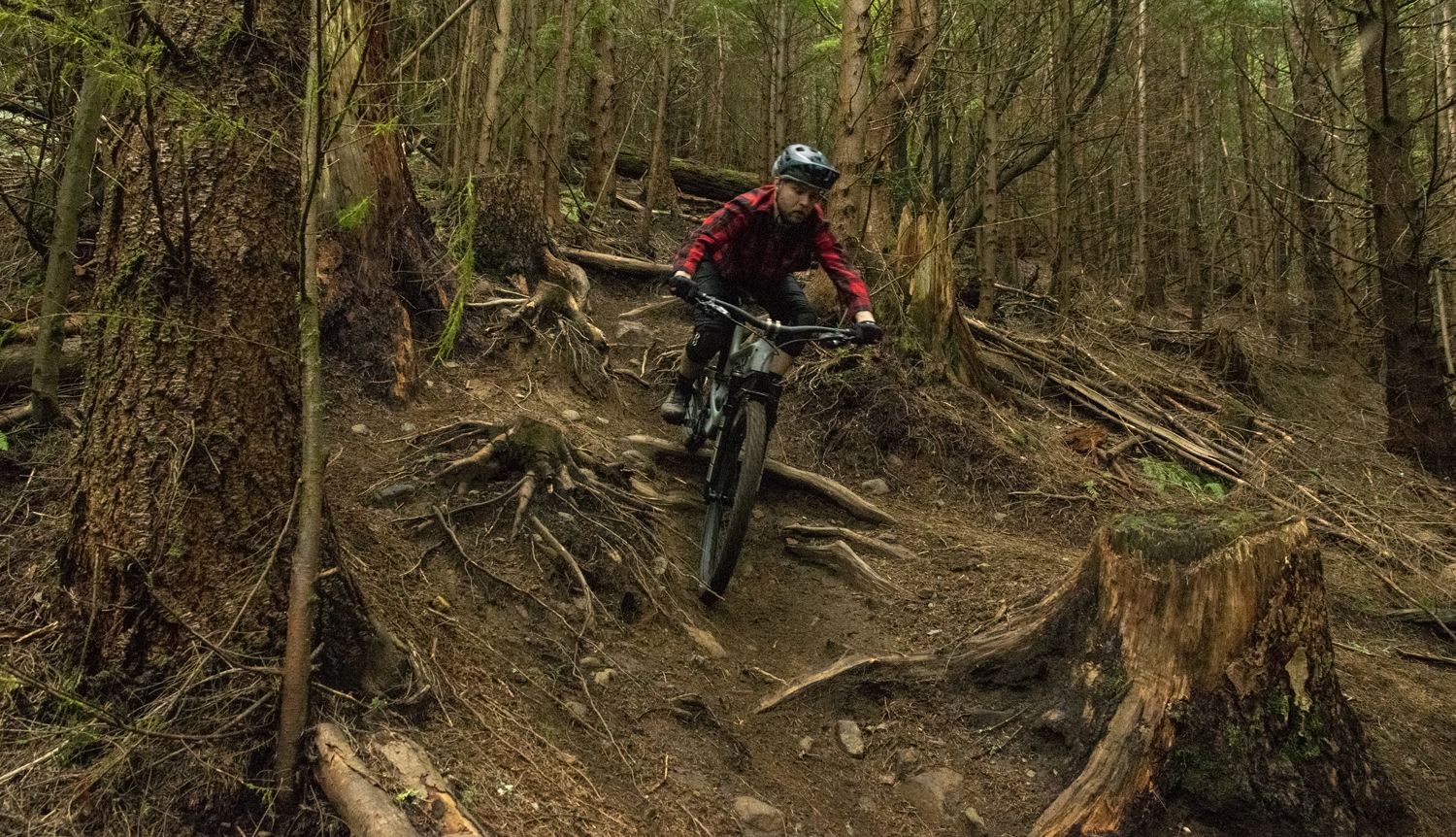
Setup
David Golay (6’, 170 lb / 183 cm, 77.1 kg): Setting up a complex electronic suspension system might sound intimidating, but it’s truly quite straightforward. Read the “Setup & Settings” section above for a rundown, but it’s very easy, once you get your head around how the controller works and what the LED indicators mean — which really just requires a quick primer and a few minutes of playing with the system.
The only real downside of Flight Attendant from a setup perspective is that you lose the high-speed compression adjuster on the fork (as compared to the fully-fledged Ultimate versions of the Pike / Lyrik / ZEB forks that it’s available on), but that’s probably a fairly minor tradeoff for most folks. Personally, I’ve mostly run the Charger 2.1 RC2 damper in the middle high-speed compression setting, anyway so I’m really not missing much.
[And for those wondering, the Flight Attendant fork damper is based on the older Charger 2.1 architecture, not the all-new Charger 3 that RockShox just rolled out.]
Zack Henderson (6′, 160 lb / 183 cm, 72.6 kg): As David mentioned in his Flash Review, there are definitely some intricacies of the Flight Attendant system to iron out when you first get things set up — mainly getting used to understanding what the various colored LEDs actually mean and how to walk through setup. The only traditional settings are air pressure and rebound, whereas the compression settings are all done via the electronics. The AXS app is super helpful and the setup is ultimately very simple, but the system has a lot of configuration options and it’s definitely a case of “read the damn manual” rather than get on and go.
On the Trail
David: I wasn’t sure what to expect when I first hopped on the Flight-Attendant-equipped Capra. On one hand, the system is essentially an automatic climb switch (at least in principle — as we’ll get into below, that somewhat flippant framing definitely sells its performance short). On the other hand, it’s an electronic system with a whole bunch of sensors and batteries that controls the suspension and dramatically changes its behavior. So would it feel relatively normal, or would the bike connect with Skynet to lock itself out on the lip of a jump and buck me to my death?
Okay, it obviously wasn’t going to do that. I think. But even though I was hopping onto an unfamiliar bike, on trails that I don’t know very well, that first ride felt… really normal. Part of that is that the YT Capra I was testing the Flight Attendant system on is a very intuitive, easy-going bike (check out our full review for a whole lot more on that) but the Flight Attendant suspension just… worked. The bike pedaled super well, but then the suspension opened up and worked normally when I needed it to. Those mode changes were accompanied by a little chirp from the servos (it sounds exactly like an AXS derailleur, for folks who are familiar with those) but that was about it. And I kept peering over the bar to look at the display on the fork to see what the system was doing, but I never caught it out, doing something that seemed wrong. The suspension was firmer when I wanted it, and open when it needed to be.
Cycling through the range of Bias Adjust settings makes a very appreciable difference in how aggressive the suspension is about firming itself up, particularly when climbing, but across the range, the choices it made feel intuitive. At -2, the suspension stays open a whole lot, and only firms up when you’re pedaling on a long, extended smooth section. At +2, it’s much quicker to firm itself up and takes a sharper impact to open up, but I still couldn’t make it do anything too weird, despite my deliberate best efforts.

After the initial experimentation period, I just left the system in the +1 Bias Adjust setting and mostly ignored it. And it worked incredibly seamlessly. The Capra pedaled remarkably well for a 160+ mm travel Enduro bike, especially given its fairly middling performance with Flight Attendant turned off, and it opened up and worked as normal suspension when I wanted it to. And so I just didn’t think about it, because I didn’t need to.
I think that having a system that defaults to being open, and only firms up the suspension when it’s confident that you want it to — within the bounds of whatever Bias Adjust setting you’ve chosen — is key to it working so well. It’s far preferable, in my book, to have the suspension stay open for a few extra seconds of pedaling effort when it maybe could have been firmed up than it is for the suspension to be in a firm mode when you hit a significant bump, especially on the way down. Even with fairly aggressive Bias Adjust settings, Flight Attendant does that very well. And in fact, I opted not to use the +2 Bias Adjust setting more for climbing comfort than for any descending performance reasons. Once the bike was pointed downhill, even the +2 setting opened up reliably when I needed it to.
The way that Flight Attendant sometimes puts the fork into one mode softer than the shock (e.g., fork in “climb” and shock in “lock”) is also key to it working well. One of the reasons that I’m generally skeptical of fork climb modes, especially on longer-travel bikes, is that firming up the fork makes it ride higher, putting the bars higher and making the seat tube angle slacker — exactly the opposite of what you want when climbs start getting steeper. And Flight Attendant compensates for that really well, both because the fork doesn’t ever firm itself up as aggressively as the shock does (“lock” mode isn’t truly a lockout on either, but it’s appreciably softer on the fork), and because it does a good job of kicking the fork down a level when the bike is pointed up something super steep. The idea behind the system isn’t really all that complicated, but the devil is absolutely in the details, and RockShox has the tuning down very, very well.
Zack: I had my own Terminator suspicions when I jumped on the Flight-Attendant-equipped Capra, and the chirping servos working away on my ride to the trailhead were definitely a new experience — exciting, but a little unsettling. Over the course of the first 30 minutes of riding, I still noticed the servo noises but found myself forgetting that the bike had anything special going on, and just rode. And I mean that as a high compliment — the electronics deliver a pretty seamless experience versus the on/off sensation that some of the more aggressive climb switches provide on traditional suspension. I wasn’t surprised that the bike climbed as well as it did, to be honest, because it’s the obvious expectation of a system like this. Where I was more surprised was in the level of resolution it provided between the open and closed settings. Less-than-steep climbs with some tech sprinkled in would send the bike into more of a middle “trail mode” range of settings, and at times the fork’s LED indicator would illuminate two LEDs at once to indicate that the system was operating in other settings in between lock, pedal, and open. This was where the Flight Attendant system really started to show its true value to me, doing a great job of balancing grip, comfort, and efficiency in sections of trail where other traditional suspension setups would have you stopping twisting knobs to find similar settings.
Personally, I found the +1 Bias Adjust setting to be great on longer, smoother climbs, but I ended up also using the baseline setting a lot. I found that the +1 setting was a bit harsh on rougher and flatter terrain, where the shock in particular would be a little too eager to return back to the “lock” setting. This is the real beauty of the bias being adjustable — it’s easy to change the behavior to suit whatever type of ride you’re in for on a given day.
I did have a couple of gripes with the system when it came to more playful riding. I like to jump off curbs and such on my way to the trailhead, try stupid log skinnies, and generally mess around a little bit when I’m on my way to the top of whatever descent I’m going for. Unfortunately, pumping the bike into something you want to try to jump over doesn’t necessarily trigger the system to switch to “open” mode, making loading the suspension for bunny hops and goofing around a whole lot harder. The suspension did always open up upon landing, but it felt like the Flight Attendant system was a little more purposeful and serious than my riding style sometimes is. Now yes, you can move the system into “open” mode manually by using the left AXS shifter, but I often forgot, and toggling through the modes was never quite second nature for me.
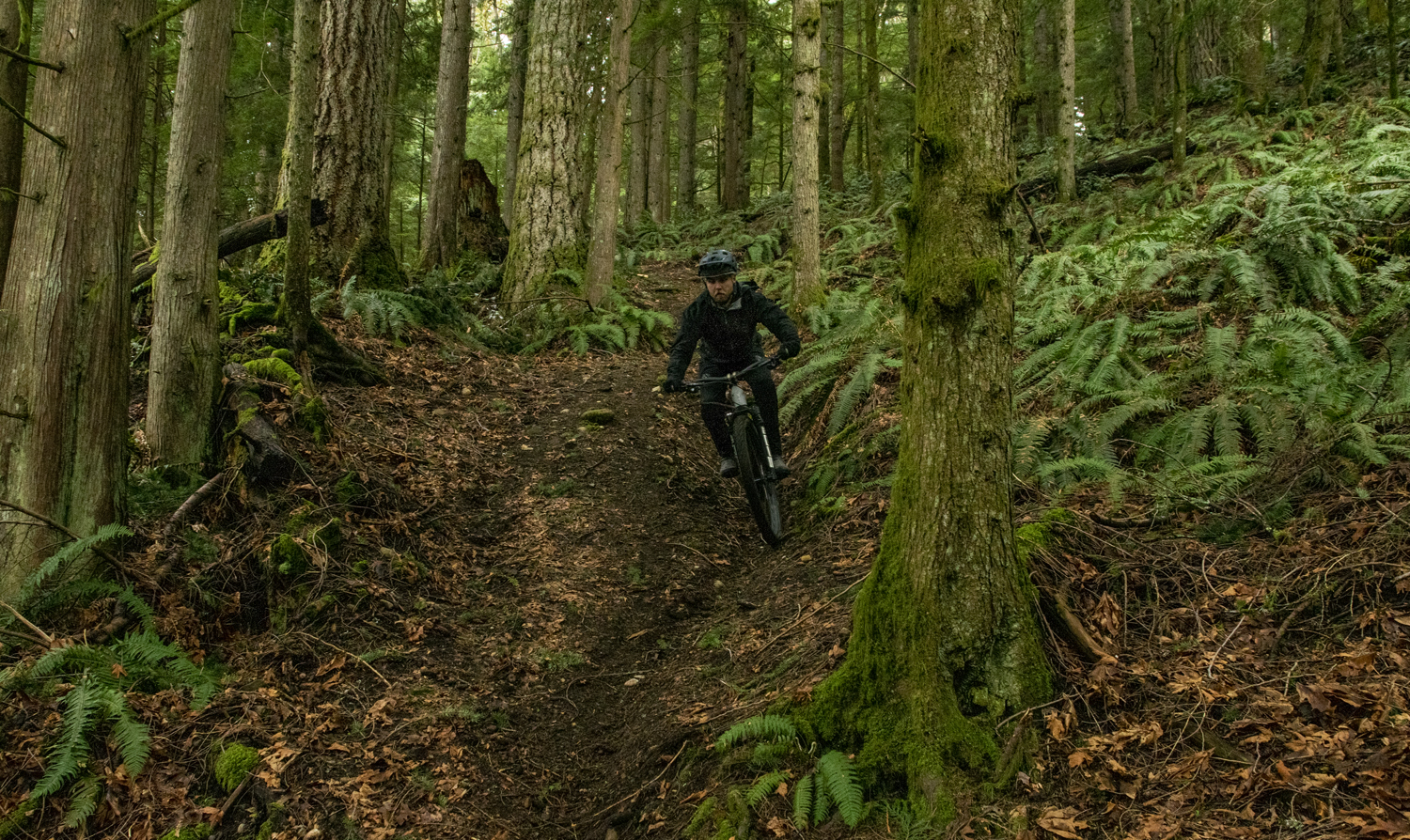
David: On a different note, Flight Attendant’s battery life is also quite good. I didn’t ever fully run the system down to the point of a dead battery, but it comfortably made it through 15+ hours of ride time without issue, and, again, the worst-case scenario is that the system gets stuck in open mode due to a dead battery, and you lose the efficiency gains that it offers. Not the end of the world by any stretch. And though I’m reluctant to add batteries to bikes without a compelling performance reason for doing so, Flight Attendant readily clears that bar in my book. I’m not saying that everyone needs it, or that you can’t have fun riding a bike without it, but it’s a very impressive system that has few downsides from a pure on-trail performance standpoint.
On the way back down, the Flight Attendant system really does feel like a normal ZEB and Super Deluxe. Or at least mostly. I truly don’t think I could tell a difference in terms of rear shock performance between the Flight Attendant Super Deluxe and the standard one with the same settings — but again, we’re talking about what is now the prior-model Super Deluxe, not the brand-new version with the RC2T damper. The fork does feel subtly tweaked, though, due to the addition of Buttercups and the new Debonair+ spring.
Long-time readers of my reviews will know that there’s a lot that I like about the original ZEB, but midstroke support was its biggest Achilles heel and one that I personally happen to care a lot about. Fortunately, the new DebonAir+ air spring does feel like it makes a real improvement on that front. It’s not going to compete with the most ultra-supportive forks out there — especially dual-positive air chamber designs, like the Manitou Mezzer Pro, Ohlins RXF36 and RXF38, and EXT Era — but it’s a real step up from the original model, and that’s very welcome. It’s also hard to exactly tell whether to credit the new air spring or the Buttercups, but the Flight Attendant ZEB does feel just a touch smoother and less harsh on high-speed, chattery sections than the original version, too. Neither of those differences is night-and-day by any stretch, but they’re solid improvements for sure.

Zack: Like David, I had no complaints about battery life and really only charged the batteries once or twice. It was very easy to quickly grab the batteries after a ride and toss them in the charger on my workbench — I know there’s a lot of anxiety around battery management with systems like this, but I found the battery life very good and the charging inconvenience minimal.
I also have generally agreed with David on his opinions about different suspension offerings, likely due to our similar trail preferences and styles. I have found RockShox’s offerings to feel a little under-damped in recent years compared to my favorite forks and shocks, and while I felt that the Super Deluxe could have benefitted from a high-speed compression adjustment and/or a firmer tune to work a little more effectively with the Capra’s leverage curve, the fork was a big leap forward — likely attributed to the much-improved air spring that seemed to hold the bike up in the midstroke far better than the prior iteration of the ZEB’s air spring.
David: I’m with Zack in that I would have liked a bit firmer high-speed compression tune on the rear shock, but I don’t see that as being an inherent limitation or issue with Flight Attendant in general (though the new non-Flight Attendant version of the Super Deluxe Ultimate does have a high-speed compression adjuster). The tune that YT selected for the Capra just didn’t feel entirely dialed to me — check out our full review of the bike for more on that.
Who’s It For?
David: Flight Attendant is expensive, especially since it’s only available on complete bikes with super high-end builds, but it makes a dramatic difference when it comes to pedaling efficiency — it’s a lot more than an automatic climb switch. And the user experience is impressively seamless, in terms of the suspension opening up when you need it to. Flight Attendant doesn’t offer any real advantages in terms of suspension performance on the way back down; rather, it’s all about improving efficiency on the way up. And if you think that sounds worth paying for, Flight Attendant is the real deal, especially on longer-travel, less efficient bikes that have more to gain on that front.
Zack: I agree with David here — Flight Attendant is so much more refined than calling it an automatic climb switch implies. Performance on rolling and flatter terrain is where it really shows its worth, and it could turn an unwieldy Enduro bike into much more of an all-arounder, depending on your riding locale. I personally found the suspension to be a little overly soft and muted while descending compared to my typical preferences, but it was pretty incredible to have that softness matched to such amazing climbing and pedaling performance. Folks who pedal fire roads to long, nasty descents will likely be best served by traditional 2-way climb switches that cost a whole lot less, but for riders who use one bike for highly varied terrain or longer, epic rides, Flight Attendant can eke out more efficiency and performance than anything else I’ve been on.
I also want to quickly speak to not just who it’s for, but the types of bikes it’s for. In my opinion, Flight Attendant is optimal for Enduro bikes because it does a great job compensating for less efficient suspension designs and setups while climbing and on flatter terrain. I’d be particularly excited to see a manufacturer design a bike around Flight Attendant — because of just how effective the system is in delivering great pedaling and climbing performance, it would free the bike designer from typical constraints and potentially open the doors to optimizing almost exclusively for descending performance.
Bottom Line
RockShox’s Flight Attendant does a seriously impressive job of improving the pedaling efficiency of longer-travel bikes with very few tradeoffs on the way back down; once the system opens up, which it reliably does when needed, it feels very much like a standard ZEB and Super Deluxe. The cost and hassle of charging batteries rightly won’t be for everyone, but the efficiency gains that Flight Attendant offers are not subtle, especially on a bike like the YT Capra which isn’t especially efficient on its own. It’s very impressive.

As a mostly ex-racer, I find this intriguing, but the idea of charging so many batteries is off-putting. The TWO batteries on my AXS road bike are annoying enough.
But no need to flip levers is pretty compelling, so it will be interesting to see how this integrates with the new RS line of forks and shocks, which must be just around the corner.
I’m expecting that a lot of racer-types will find the system particularly appealing – never having to even think about touching a climb switch is addictive, especially on rides where you really want to just shut your brain off and charge.
I’ll admit that I was skeptical of having more batteries, and while it certainly isn’t ideal, charging 2 more batteries for the Flight Attendant fork and shock didn’t prove all that much of a pain compared to charging an AXS derailleur and seatpost. My solution was to have 2 chargers plugged in at the same time, swapping batteries once to get through all 4 that the bike had. I’d personally love to see SRAM offer a charger that can accommodate up to 4 batteries at once to simplify things further.
A 4 SRAM battery charger sounds awesome!
E -Fork? I feel like this legitimizes what people with handlebar “lock out levers” have known for a long time. I would like to see “twin loc” type levers offered on more bikes because It’s much cheaper is becomes 2nd nature just like a dropper.
Im having a hard time supporting so much technology on every aspect of your bike.
I can’t be the only one that enjoys the mountain bike for what it does.. allows me to enjoy outdoors.
Does any one else feel like there is a growing need to add more tec is taken away from what the intended product was designed for?
Here’s an alternative way to look at the additional batteries needed. For those of us already hooked on AXS shifting and dropper post, we run the risk of having non-functional shifting or dropper post if a battery dies. I’ve had it happen a couple of times when I wasn’t paying attention, and ended up dropping the seat and leaving the functional battery in the derailleur.
Considering the Flight Attendant automatically reverts to Open mode if a battery dies, I would look at this as a benefit having 2 more batteries on the bike. If the derailleur or dropper battery dies, you’ve got a spare right there and the only downside is having to run your fork or shock in open mode…which a lot of people do all the time anyway.
This is bleeding edge stuff so of course it’s going to be expensive. I can’t afford to buy a McClaren or Ferrari but I can get the mountain bike equivalent which is awesome.